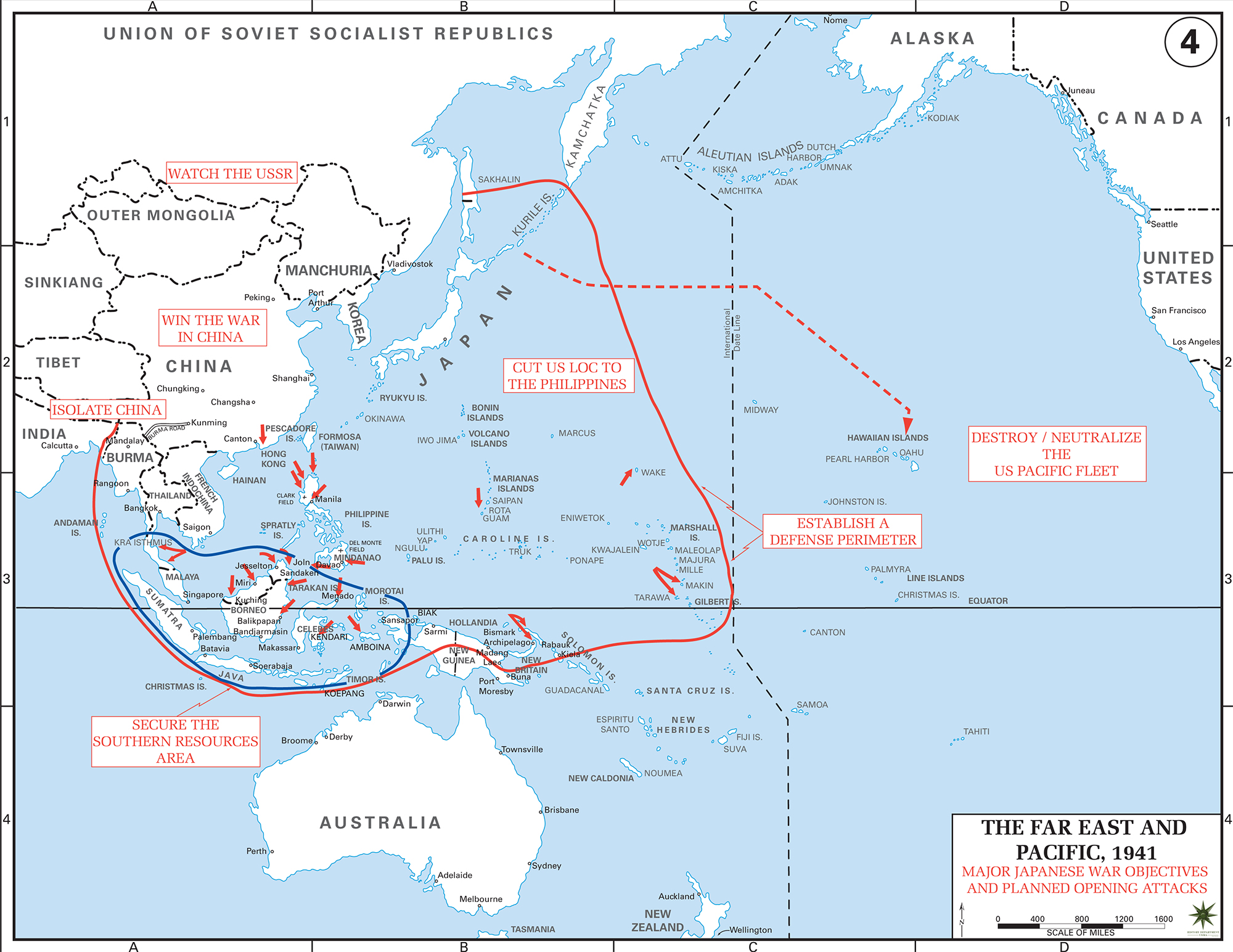Map Description
History Map of WWII: The Far East and the Pacific 1941
Illustrating:
Major Japanese War Objectives and Planned Opening Attacks
大東亜共栄圏 (Dai Tōa Kyōeiken) — The "Greater East Asia Co-Prosperity Sphere"
大東亜 (Dai Tōa) = Greater East Asia
共栄圏 (Kyōeiken) = Co-Prosperity Sphere
This was Japan's effort to unite Asian countries under Japanese
leadership and free them from Western colonial powers — though in practice, it mostly served Japan’s imperial and resource needs.
To achieve this, Japanese leadership recognized that conflict with
the United States, Britain, and the Netherlands was inevitable. Their strategy involved delivering rapid, overwhelming strikes
across multiple locations to neutralize Western military power in the Pacific and secure vital resources, particularly oil,
from Southeast Asia. They hoped that such a swift and coordinated offensive would force the Allies into a negotiated settlement
favorable to Japan before they could mount an effective response.
The execution of this plan began on December 7, 1941, with the surprise attack on Pearl Harbor (Hawaii local time).
Within hours,
on December 8 (local times), Japan launched nearly simultaneous assaults on the Philippines, Guam, Wake Island, British Malaya
(including Singapore), Hong Kong, and initiated operations against the Dutch East Indies.
The attack on Wake Island began with
bombing raids, eventually resulting in Japanese capture after weeks of fighting. On Guam, following initial air assaults,
the main engagement occurred on December 10, with the island quickly falling to Japanese forces.
These coordinated strikes
continued with operations against Burma, Borneo, Rabaul, and the Gilbert Islands as Japan rapidly expanded its military footprint
across the Pacific and Southeast Asia, systematically targeting US, British, and Dutch territories as part of their expansionist ambitions.
:: Watch the USSR ::
Japan maintained strong forces in Manchuria and kept a wary eye on the Soviet Union, fearing a potential Soviet
attack from Siberia, especially after the Soviet victory at Khalkhin Gol (1939). While focusing southward, Japan
sought to avoid a two-front war and thus signed the Soviet–Japanese Neutrality Pact (April 1941) to secure its
northern flank before launching operations in Southeast Asia and the Pacific.
:: Win the war in China ::
Japan aimed to decisively defeat the Nationalist Chinese forces led by Chiang Kai-shek, but by 1941
the Second Sino-Japanese War had stalemated.
Japanese strategy shifted toward a "China incident solution" by cutting off Chinese supply
routes and hoping to force a political settlement through isolation and attrition rather than total battlefield conquest.
:: Isolate China ::
To choke off China's external support, Japan sought to cut land supply routes like the Burma Road and
block sea access. By invading Southeast Asia (e.g., Indochina) and planning operations against Burma, Japan aimed
to strangle Chinese resistance by eliminating Allied aid and severing logistical lifelines.
:: Secure the southern resources area ::
Japan needed oil, rubber, and other raw materials to sustain its military campaigns and economy. Facing embargoes
from the US, Britain, and the Netherlands, it targeted the "Southern Resource Area" — primarily the Dutch East
Indies, Malaya, and Burma — aiming to seize these territories swiftly to fuel a protracted war effort.
:: Cut US lines of communication (LOC) to the Philippines ::
Control of islands like Guam, Wake, and others was essential to sever American logistical links to the Philippines,
preventing US reinforcements and supply from reaching its colonial outpost and making it easier for Japan to
conquer the Philippines without prolonged interference.
:: Establish a defense perimeter ::
Japan intended to build a fortified perimeter stretching from the Kuril Islands through the Central Pacific
(including the Marianas, Carolines, and Marshalls) down to New Guinea. This would create a strategic buffer
zone, forcing the US into a long, costly campaign should it attempt to breach Japan's newly won territories.
:: Destroy / Neutralize the US Pacific Fleet ::
To enable unhindered expansion and delay US counterattacks, Japan sought to cripple American naval power with a
surprise attack. The attack on Pearl Harbor (December 7, 1941)
aimed to neutralize the US Pacific Fleet,
buying Japan six months to consolidate its gains and fortify its defensive perimeter before American industrial
might could be brought to bear.
Credits
Courtesy of the United States Military Academy Department of History.
Related Links
About the Second World WarWWII Timelines

